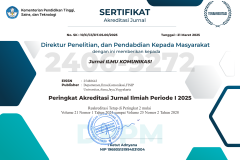REPRESENTASI ISLAM DALAM FILM HOLLYWOOD JAVA HEAT
DOI:
https://doi.org/10.24002/jik.v18i2.3700Keywords:
Hollywood Movies, Islam, Semiotics, Java Heat, film Hollywood, semiotika, terorisAbstract
Artikel ini mendikusikan tentang representasi Islam dalam film Hollywood berjudul JavaHeat yang diproduksi di Indonesia. Penelitian ini menggunakan analisis semiotika Roland Barthesmelalui tiga tahap pemaknaan: denotatif, konotatif, dan mitos. Hasil penelitian menunjukkan bahwarepresentasi Islam dengan cita rasa Hollywood terbagi menjadi dua. Pertama, Islam Arab yangdirepresentasikan sebagai umat penuh kekerasan, hipokrit, dan lekat dengan terorisme. Kedua,Islam bergaya Amerika yang direpresentasikan sebagai Islam pluralis dan bersedia melakukannegosiasi dengan Amerika Serikat.
References
Ahmed, A. S., 1993. Posmodernisme Bahaya dan Harapan bagi Islam. Bandung: PT Mizan Pustaka.
Budiman, K., 2011. Semiotika Visual; Konsep, Isu, dan Problem Ikonisitas. Yogyakarta: Jalasutra.
Eriyanto, 2001. Analisis Wacana : Pengantar Analisis Teks Media. Yogyakarta: LKiS.
Hoed, B. H., 2011. Semiotk: Dinamika Sosial Budaya. Depok: Komunitas Bambu.
Kellner, D., 2003. Media Culture. London: Rouletdege.
Sobur, A., 2004. Semiotika Komunikasi. Bandung: PT. Remaja Rosdakarya Offset.
Sunardi, 2002. Semiotika Negative. Yogyakarta: Kanal.
Tony Thwaites, L. D., 2002. Introducting Cultural and Media Studies: Semiotic Approach. New York: Palgrave Hampshire.
Downloads
Published
How to Cite
Issue
Section
License
Jurnal ILMU KOMUNIKASI is an academic journal. As such, it is dedicated to the open exchange of information. For this reason, JIK is freely available to individuals and institutions. Authors who publish in Jurnal ILMU KOMUNIKASI will release their articles under the Creative Commons Attribution (BY) License. This license allows anyone to copy and redistribute the article in any medium or format as well as remix, transform, and build upon the material for any purpose, even commercially as long as they credit the authors for the original creation. For details of the rights authors grants users of their work, see the "human-readable summary" of the license, with a link to the full license. (Note that "you" refers to a user, not an author, in the summary)
 This work is licensed under a Creative Commons Attribution 4.0 International License.
This work is licensed under a Creative Commons Attribution 4.0 International License.














